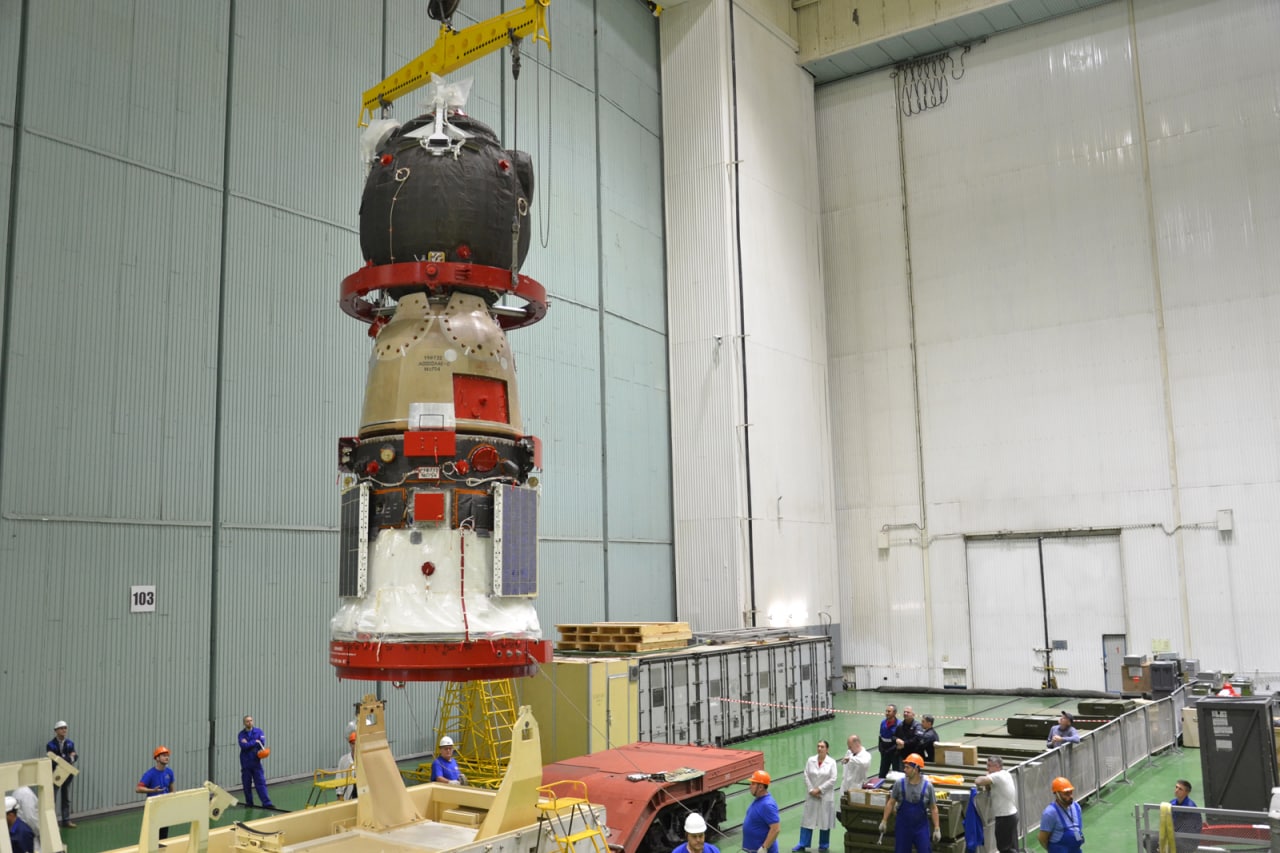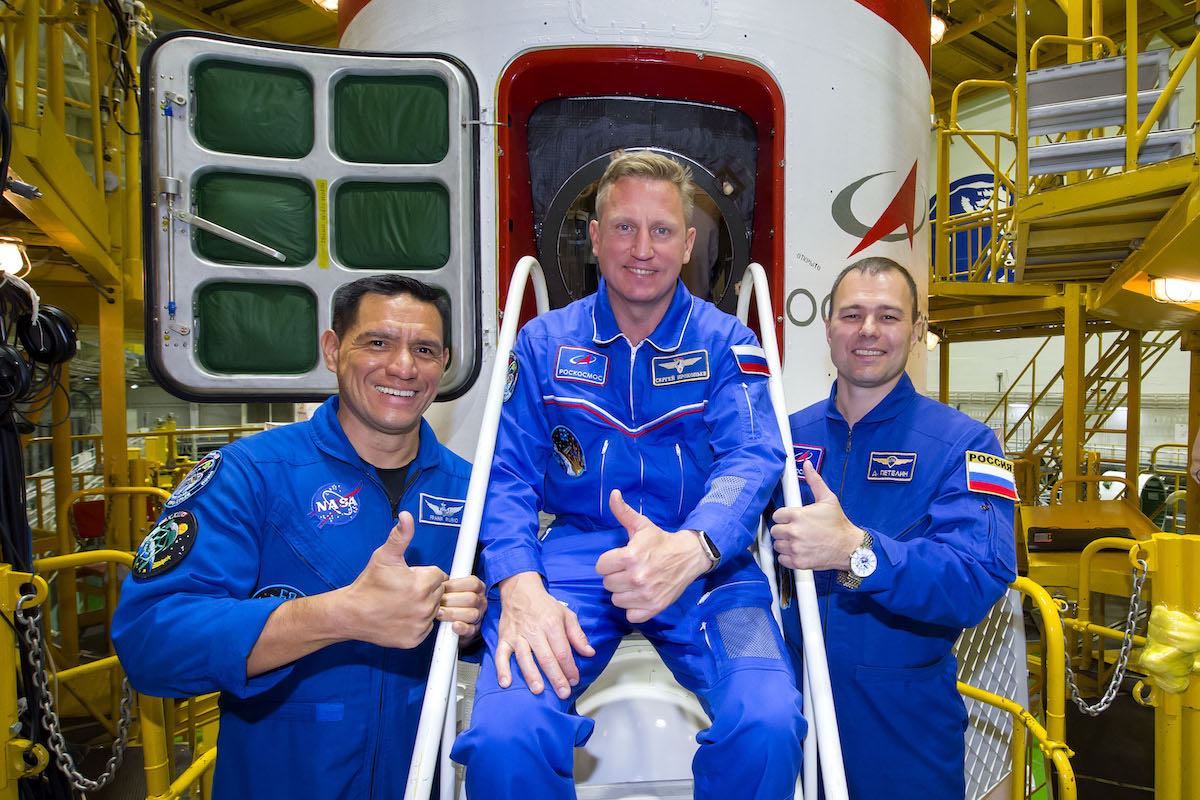
Russian space agency and NASA officials said Wednesday they will accelerate the launch of the next Soyuz spacecraft to the International Space Station, and fly it to the complex next month without anyone on-board to replace a Soyuz crew ferry ship damaged Dec. 14 by a high-speed impact, likely from a tiny particle from deep space.
The schedule shuffle will mean NASA astronaut Frank Rubio and Russian cosmonauts Sergey Prokopyev and Dmitri Petelin will remain on the space station several months beyond their planned return to Earth in late March, officials said.
The three-man Soyuz crew make up part of the Expedition 68 crew on the space station, alongside a crew of four that arrived in October on a SpaceX Crew Dragon spacecraft as part of regularly-scheduled crew rotations flown on Russian and U.S. ferry ships.
“We’re not calling it a rescue Soyuz,” said Joel Montalbano, NASA’s space station program manager, in a conference call with reporters Wednesday. “Right now, the crew is safe on-board the space station. I’m calling it a replacement Soyuz. This is the next Soyuz that was scheduled to fly in March. It will just fly a little earlier.”
Roscosmos, Russia’s space agency, said engineers have “experimentally proven” that a radiator pipe on the Soyuz MS-22 spacecraft was damaged by an impact Dec. 14, creating a hole smaller than 1 millimeter in the cooling loop. Coolant fluid leaked out through the hole over several hours, visible as a cloud of particles around the Soyuz spacecraft docked to the Rassvet module on the Russian section of the space station.
The leak started as Prokopyev and Petelin were preparing for a spacewalk outside the space station. Russian mission controllers delayed the spacewalk to focus on the problem with the Soyuz spacecraft, and officials launched an investigation into the cause and consequences of the leak.
Russia’s space agency said Wednesday that the launch of the next Soyuz spacecraft, Soyuz MS-23, will move up to Feb. 20 from the original target date of March 16. The Soyuz MS-23 spacecraft was supposed to launch with Russian cosmonauts Oleg Kononenko, Nikolai Chub, and NASA astronaut Loral O’Hara to begin a six-month expedition, replacing Prokopyev, Petelin, and Rubio, who were scheduled to return to Earth on their Soyuz MS-22 spacecraft March 28.
Under the new plan, the Soyuz MS-23 spacecraft will launch without a crew, bumping Kononenko, Chub, and O’Hara to a later Soyuz flight. Prokopyev, Petelin, and Rubio will return to Earth on the Soyuz MS-23 spacecraft later this year, following the launch of the next Soyuz crew on the Soyuz MS-24 spacecraft.
“We will probably extend the stay of this crew, Expedition 68, on the station for an extra several months,” said Sergei Krikalev, executive director of human spaceflight programs at Roscosmos. “What will be the exact date to send replacements for them is not decided yet, but it’s going to be several months longer mission.”
The Soyuz MS-23 spacecraft is already at the launch site at the Baikonur Cosmodrome in Kazakhstan, where it will be connected with its Soyuz rocket ahead of liftoff next month.
Montalbano said ground teams informed the crew of the extension to their mission, which could last until September, the original schedule for the launch of the Soyuz MS-24 mission.
“The crews are prepared,” Montalbano said.”They’re prepared to stay until the September launch date if that’s the case. If they go earlier and that launch date moves up earlier, then they’re prepared to come home earlier … They are ready to go with whatever decision that we give them.”
Krikalev said medical teams have cleared Prokopyev, Petelin, and Rubio for a longer stay in space.
After the launch and docking of the new Soyuz MS-23 ferry ship next month, Russia’s space agency plans to transfer spacesuits, custom seat liners, and emergency equipment from the Soyuz MS-22 spacecraft over to the replacement vehicle. Then the Soyuz MS-22 spacecraft will depart the station some time in March without any crew and head for an automated landing in Kazakhstan.
The Soyuz MS-22 spacecraft launched Sept. 21 from Baikonur, carrying Prokopyev, Petelin, and Rubio to the space station for a planned half-year mission. Rubio flew on the Soyuz spacecraft under a new barter agreement between NASA and Roscosmos, which allows U.S. astronauts to continue flying to the station on Russian missions in exchange for the ability for Russian cosmonauts to fly on commercial SpaceX crew capsules under contract to NASA.
The no-funds-exchanged agreement is designed help ensure there is always at least one NASA astronaut and one Russian cosmonaut on the space station at all times, even if there are delays or groundings of Soyuz or SpaceX missions, to operate systems on the U.S. and Russian segments of the orbiting outpost.
The Soyuz MS-22 spacecraft has been leaking apparent coolant fluid more than three hours. International Space Station managers are discussing the situation.
The cosmonauts who were preparing for tonight’s spacewalk are safely back in the space station.https://t.co/2lnIsF9yec pic.twitter.com/Sbc6k8iiA2
— Spaceflight Now (@SpaceflightNow) December 15, 2022
Krikalev, a former Russian cosmonaut with flights on Russia’s Mir space station, the International Space Station, and NASA space shuttles, said investigators determined the hole in the Soyuz MS-22 coolant system was likely caused by an impact from a micrometeoroid, or a tiny rock fragment that came from deep space.
“We saw liquid going out from the radiator out to space,” Krikalev said. “Initially, we started to check if we may have some kind of technical or technological problem that could cause this kind of malfunction.”
But officials ruled out a technical problem as the cause for the leak after finding a hole in the radiator coolant pipe, located on the Soyuz spacecraft’s rear equipment module, during an inspection by the space station’s Canadian-built robotic arm. Russian engineers also performed an experiment with a high-velocity gun, firing a small particle at an aluminum plate representative of the Soyuz radiator coolant pipe.
“Our result from this test completely coincides with our calculation, so our current theory is that this was caused by a small particle about 1 millimeter in diameter and a velocity of about 7 kilometers per second,” Krikalev told reporters Wednesday.
According to Krikalev, Russian investigators concluded the hole on the Soyuz spacecraft was caused by a naturally-occurring meteoroid, and not a piece of human-made space junk, because of calculations about the velocity of the impact.
“We think that this is a meteoroid (and not a piece of space junk) because some other object on this orbit cannot exist,” Krikalev said. “Because it has such a high velocity, it wouldn’t stay on this orbit.
“That’s why we think it’s some kind of meteorite coming from a random direction,” he said.
Montalbano, NASA’s space station manager, agreed with Krikalev’s assessment, and added that information catalogued during the manufacturing Soyuz MS-22 spacecraft indicated there were no defects in the radiator system before launch.
“Everything points to micrometeoroid debris,” Montalbano said. “So far, we are in concurrence with Roscosmos.”
Krikalev said any attempt to repair the hole on the Soyuz radiator would be “so difficult and so risky” that it would be less risky to launch a replacement for the Soyuz MS-22 spacecraft.
Without the cooling system, temperatures inside the Soyuz MS-22 spacecraft could reach higher than 100 degrees Fahrenheit (40 degrees Celsius) with a crew on-board, Krikalev said.
“That itself is not so high, but the problem is in a small volume, the humidity could be high, and the crew may overheat with high temperature and high humidity,” he said.
“The main problem on the current Soyuz with the crew would be the thermal condition because we lost heat rejection capability on the Soyuz,” Krikalev said. “In the case where we have crew inside and we have all equipment switched on, we may have a high temperature situation on the Soyuz equipment compartment and crew compartment.”
Russian officials believe is enough redundancy on the Soyuz spacecraft for the capsule to land safely, even if systems inside the spacecraft overheat.
“As for re-entry, we expect that maybe we will have some overheating of equipment,” Krikalev said. “Still, we think that Soyuz has several layers of redundancy. If the computer fails, we have capability to continue re-entry mode with analog equipment. So we have several layers of redundancy. So we think that Soyuz will return back safely.”

Until the new Soyuz spacecraft arrives next month, the Soyuz MS-22 vehicle remains the lifeboat for Prokopyev, Petelin, and Rubio to escape the space station if an emergency forces an evacuation of the complex. Besides the radiator, all other systems on the Soyuz MS-22 spacecraft remain healthy, including its control thrusters, Montalbano said.
In the unlikely event of an evacuation, NASA and Roscosmos are working with SpaceX to potentially accommodate at least one of the Soyuz MS-22 crew members on SpaceX’s Crew Dragon spacecraft docked at the space station. SpaceX’s Dragon Endurance spacecraft delivered NASA astronauts Nicole Mann, Josh Cassada, Japanese astronaut Koichi Wakata, and Russian cosmonaut Anna Kikina to the station in October on the Crew-5 mission.
The Dragon capsule has four seats, all of which would be filled during an emergency evacuation of the space station. Montalbano said at least one extra crew member, and maybe more, could ride back to Earth on the Dragon spacecraft in an area normally used for cargo storage.
“If we had to evacuate, we will not have extra seats or suits for extra crew members coming home, that’s why you only want to do it in a contingency,” Montalbano said. “We have a plan using hardware from Soyuz to safely secure crew members in the area that the cargo normally returns on Dragon.”
Krikalev said potential overheating on the Soyuz MS-22 spacecraft during an emergency evacuation could be reduced if it returned to Earth with just one or two crew members, instead of the full complement of three people.
“That’s why we are looking at options that, if we need to use Soyuz in case of emergency, we may reduce the size of the crew in order to reduce the heat load on the crew for landing conditions,” he said.
SpaceX’s Crew-5 mission is scheduled to return to Earth this spring, following the launch of their replacements on SpaceX’s Crew-6 mission. The launch from Florida of the Crew-6 mission, with four crew members from the United States, Russia, and the United Arab Emirates, was scheduled for Feb. 19 but will likely be delayed at least a couple of weeks until after the launch and docking of the Soyuz MS-23 spacecraft to replace the damaged Soyuz MS-22 vehicle.
Montalbano said space station managers will also re-evaluate schedules for other missions launching to the orbiting complex over the next few months, including resupply missions by SpaceX and Northrop Grumman, a long-delayed crew test flight on Boeing’s Starliner spacecraft, and a commercial astronaut mission for Axiom Space on a SpaceX crew capsule.
Email the author.
Follow Stephen Clark on Twitter: @StephenClark1.
from Spaceflight Now https://ift.tt/RS3autX
via World Space Info







0 comments:
Post a Comment